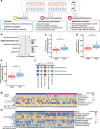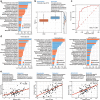Integrative metagenomic and metabolomic analyses reveal gut microbiota-derived multiple hits connected to development of gestational diabetes mellitus in humans
- PMID: 36550785
- PMCID: PMC9794004
- DOI: 10.1080/19490976.2022.2154552
Integrative metagenomic and metabolomic analyses reveal gut microbiota-derived multiple hits connected to development of gestational diabetes mellitus in humans
Abstract
Gestational diabetes mellitus (GDM) is characterized by the development of hyperglycemia and insulin resistance during the second or third trimester of pregnancy, associated with considerable risks to both the mother and developing fetus. Although emerging evidence suggests an association between the altered gut microbiota and GDM, remarkably little is known about the microbial and metabolic mechanisms that link the dysbiosis of the gut microbiota to the development of GDM. In this study, a metagenome-wide association study and serum metabolomics profiling were performed in a cohort of pregnant women with GDM and pregnant women with normal glucose tolerance (NGT). We identified gut microbial alterations associated with GDM and linked to the changes in circulating metabolites. Blood metabolite profiles revealed that GDM patients exhibited a marked increase in 2-hydroxybutyric acid and L-alpha-aminobutyric acid, but a decrease in methionine sulfoxide, allantoin, and dopamine and dopaminergic synapse, when compared with those in NGT controls. Short-chain fatty acid-producing genera, including Faecalibacterium, Prevotella, and Streptococcus, and species Bacteroides coprophilus, Eubacterium siraeum, Faecalibacterium prausnitzii, Prevotella copri, and Prevotella stercorea, were significantly reduced in GDM patients relative to those in NGT controls. Bacterial co-occurrence network analysis revealed that pro-inflammatory bacteria were over-represented as the core species in GDM patients. These microbial and metabolic signatures are closely associated with clinical parameters of glucose metabolism in GDM patients and NGT controls. In conclusion, we identified circulating dopamine insufficiency, imbalanced production of SCFAs, and excessive metabolic inflammation as gut microbiota-driven multiple parallel hits linked to GDM development. This work might explain in part the mechanistic link between altered gut microbiota and GDM pathogenesis, and suggest that gut microbiota may serve as a promising target to intervene in GDM.
Keywords: Glucose intolerance; insulin resistance; metabolic inflammation; microbial metabolite.
Conflict of interest statement
No potential conflict of interest was reported by the author(s).
Figures







Similar articles
-
Interactions between host and gut microbiota in gestational diabetes mellitus and their impacts on offspring.BMC Microbiol. 2024 May 10;24(1):161. doi: 10.1186/s12866-024-03255-y. BMC Microbiol. 2024. PMID: 38730357 Free PMC article. Review.
-
Altered gut microbiota and metabolite profiles in community-acquired pneumonia: a metagenomic and metabolomic study.Microbiol Spectr. 2025 Apr;13(4):e0263924. doi: 10.1128/spectrum.02639-24. Epub 2025 Mar 10. Microbiol Spectr. 2025. PMID: 40062854 Free PMC article.
-
Metagenomic analysis reveals gestational diabetes mellitus-related microbial regulators of glucose tolerance.Acta Diabetol. 2020 May;57(5):569-581. doi: 10.1007/s00592-019-01434-2. Epub 2019 Dec 9. Acta Diabetol. 2020. PMID: 31820107
-
Gestational diabetes is associated with change in the gut microbiota composition in third trimester of pregnancy and postpartum.Microbiome. 2018 May 15;6(1):89. doi: 10.1186/s40168-018-0472-x. Microbiome. 2018. PMID: 29764499 Free PMC article.
-
Relationship between gut microbiota and the pathogenesis of gestational diabetes mellitus: a systematic review.Front Cell Infect Microbiol. 2024 May 28;14:1364545. doi: 10.3389/fcimb.2024.1364545. eCollection 2024. Front Cell Infect Microbiol. 2024. PMID: 38868299 Free PMC article.
Cited by
-
Eubacterium siraeum suppresses fat deposition via decreasing the tyrosine-mediated PI3K/AKT signaling pathway in high-fat diet-induced obesity.Microbiome. 2024 Oct 30;12(1):223. doi: 10.1186/s40168-024-01944-4. Microbiome. 2024. PMID: 39478562 Free PMC article.
-
Interactions between host and gut microbiota in gestational diabetes mellitus and their impacts on offspring.BMC Microbiol. 2024 May 10;24(1):161. doi: 10.1186/s12866-024-03255-y. BMC Microbiol. 2024. PMID: 38730357 Free PMC article. Review.
-
Association of Vegetables-Fruits Dietary Patterns with Gestational Diabetes Mellitus: Mediating Effects of Gut Microbiota.Nutrients. 2024 Jul 17;16(14):2300. doi: 10.3390/nu16142300. Nutrients. 2024. PMID: 39064743 Free PMC article.
-
Multi-omics profiling of dairy cattle oxidative stress identifies hindgut-derived Phascolarctobacterium succinatutens exhibiting antioxidant activity.NPJ Biofilms Microbiomes. 2025 Apr 22;11(1):61. doi: 10.1038/s41522-025-00698-7. NPJ Biofilms Microbiomes. 2025. PMID: 40263287 Free PMC article.
-
Short-Chain Fatty Acids Are Potential Biomarkers of Immune Regulation in Diabetic Retinopathy.Invest Ophthalmol Vis Sci. 2025 Jun 2;66(6):23. doi: 10.1167/iovs.66.6.23. Invest Ophthalmol Vis Sci. 2025. PMID: 40478560 Free PMC article.
References
Publication types
MeSH terms
Substances
LinkOut - more resources
Full Text Sources
